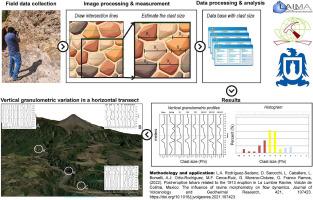Modal optical granulometry: An easy-to-use methodology to quantitatively determine particle size in consolidated and inaccessible deposits
IF 1.9
Q2 MULTIDISCIPLINARY SCIENCES
引用次数: 0
Abstract
This work presents a methodology called Modal Optical Granulometry (MOG), designed to quantitatively analyze particle size in consolidated or inaccessible deposits. This optical, non-invasive, low-cost method enables the generation of grain size profiles from digital photographs without the need for physical sampling. MOG is based on stereological principles, which involves measuring the intersections between superimposed horizontal lines and clasts in calibrated images. The technique consists of three stages: (1) photographing or filming the outcrop with a visible scale in the field, (2) image analysis using software such as Image Pro Plus or free alternatives, and (3) data processing using a custom-designed Excel spreadsheet. In addition to general granulometric analysis, the method enables the construction of Vertical Granulometric Profiles (VGP) and the analysis of Longitudinal Grain Size Evolution (LGE) along the deposit, providing valuable information on the dynamics of pyroclastic flows, lahars, and other sedimentary processes. The methodology is validated through a case study at Colima Volcano (Mexico), demonstrating its effectiveness in identifying depositional units and subtle textural variations. The technique also shows potential applications in other fields, such as, economic geology, and hydrological connectivity studies, due to its ability to deliver accurate and representative data in an accessible manner.
Bullet points:
Optical methodology for quantitative particle size analysis in volcaniclastic deposits
Non-invasive technique suitable for inaccessible or consolidated outcrops
Easy-to-use, robust, low-cost optical granulometry method.

模态光学粒度测定法:一种易于使用的方法来定量确定固结和难以接近的沉积物的粒度
这项工作提出了一种称为模态光学粒度测定法(MOG)的方法,旨在定量分析固结或不可接近矿床的粒度。这种光学、非侵入性、低成本的方法可以在不需要物理采样的情况下从数字照片中生成粒度剖面。MOG基于立体学原理,测量校准图像中重叠水平线和分类之间的交点。该技术包括三个阶段:(1)在野外以可见比例尺拍摄露头,(2)使用image Pro Plus或免费替代品等软件进行图像分析,(3)使用定制设计的Excel电子表格进行数据处理。除了一般的粒度分析外,该方法还可以构建垂直粒度剖面(VGP)和纵向粒度演化分析(LGE),为火山碎屑流、火山泥流和其他沉积过程的动力学提供有价值的信息。通过对Colima火山(墨西哥)的案例研究,验证了该方法在识别沉积单元和细微结构变化方面的有效性。由于该技术能够以可访问的方式提供准确且具有代表性的数据,因此在经济地质学和水文连通性研究等其他领域也显示出潜在的应用前景。要点:火山碎屑沉积物中定量粒度分析的光学方法;适用于难以接近或固结露头的非侵入性技术;易于使用、可靠、低成本的光学粒度测定法。
本文章由计算机程序翻译,如有差异,请以英文原文为准。
求助全文
约1分钟内获得全文
求助全文
来源期刊

MethodsX
Health Professions-Medical Laboratory Technology
CiteScore
3.60
自引率
5.30%
发文量
314
审稿时长
7 weeks
期刊介绍:
 求助内容:
求助内容: 应助结果提醒方式:
应助结果提醒方式:


